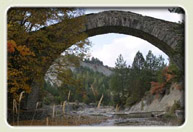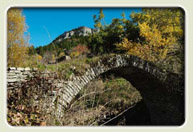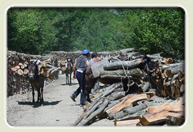|
Monuments, villages, communities,
productive activities

 The monasteries and churches The monasteries and churches |
Human history of so many centuries is etched on the Mt. Gramos
area. In Lianotopi, below the Gramos valley, the small
post-byzantine stone wall church of Agios Zaharias survives to the
present day. Lower in the community of Agia Anna just outside
Nestorio, the historic monastery complex of Tsouka also survives.
The three churches and other buildings built perpendicular to the
cliffs are a post-byzantine architectural monument. We also find
other old monasteries and stone wall churches from the byzantine
period up to the 19th century; in Nestorio the three aisle basilica of
Pammegisti Taxiarhes, in Trilofo the abandoned monastery of Agios Georgios and the village churches, in Pefkos the Zoodohos Pigi
monastery, in Ptelea the chapel of Agios Nicolaos Petritis, in
Eptahori the Monastery of Agios Georgios. |
|
|
 Settlements and villages Settlements and villages
Old, abandoned settlements, which over time have been
incorporated into the natural environment are scattered across the
mountain. Today, they are important elements of the landscape
from an aesthetical but also an ecological point of view, since they
offer additional shelter to wildlife. At the same time, there are active
rural centers and they are developing; Nestorio, the 'entrance' to
Gramos mountain, Agia Anna with the Tsouka monastery, Ptelea,
Stena, Kranohori built on the location of the ancient roman town of
Battyna, Nea Kotyli, Palia Kotyli, Kypseli, Livadotopi, Giannohori, Monopylo,
Trilofos, Glykoneri, Peristera, Lianotopi, Pefkos, all villages with stone houses
in the forest and superb view of the mountain. Gramos in the alpine
meadows below the mountain peaks, Dipotamia, Komninades,
Hionato, Mesovrahos and Kali Vrysi, which serves as base camp for
expeditions on the northern forest covered slopes of Mt. Gramos,
Ieropygi and Dendrohori, Eptahori, Zouzouli, Pefkofyto and
Chryssi in the Sarantaporos valley, Vrahos and Lagga in Ontria,
Pyrsogianni, Bourbiani, Gorgopotamos, Hionades and Plikati on the
frontier, all historic mastorohoria built inside rich forests and
Aetomilitsa in high altitude.
  |
|

 Local economies Local economies
 Local economies are mainly based on livestock farming, forestry
and recently, tourism. Cows, sheep and goats provide excellent
quality milk for the special local hard cheeses as kasseri, kefalotyri,
kefalograviera and feta. Logging, organized by the Forest Service
(local Forest Service Offices) is done on a sustainable basis and
remains one of the main land uses. Tall conifer forests especially are
distinguished by their high productivity. At lower altitudes,
production is augmented by farming. Farming products include the
famous white and multicolored beans from Kastoria, mountain
apples and of course chestnuts and walnuts. Local economies are mainly based on livestock farming, forestry
and recently, tourism. Cows, sheep and goats provide excellent
quality milk for the special local hard cheeses as kasseri, kefalotyri,
kefalograviera and feta. Logging, organized by the Forest Service
(local Forest Service Offices) is done on a sustainable basis and
remains one of the main land uses. Tall conifer forests especially are
distinguished by their high productivity. At lower altitudes,
production is augmented by farming. Farming products include the
famous white and multicolored beans from Kastoria, mountain
apples and of course chestnuts and walnuts.
|
|
|
 Ελληνική έκδοση Ελληνική έκδοση |
|
